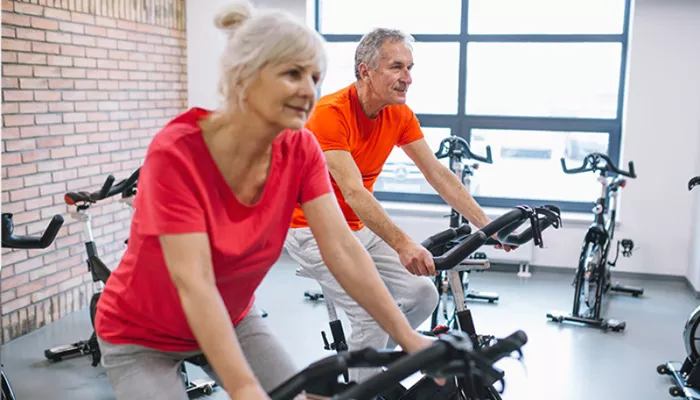Orthostatic hypotension (OH), also known as postural hypotension, is a condition characterized by a sudden drop in blood pressure upon standing. This drop can lead to dizziness, fainting, and even falls, especially in older adults. While medical management remains crucial, non-pharmacological strategies — especially targeted physical exercises — play a vital role in long-term symptom control and quality of life improvement.
This article outlines the most effective and scientifically supported exercises for individuals with orthostatic hypotension.
We’ll examine the physiology behind the condition, the importance of physical activity in its management, and detail specific routines that help stabilize blood pressure during postural changes.
Understanding Orthostatic Hypotension
Orthostatic hypotension occurs when the autonomic nervous system fails to compensate for the gravitational shift in blood upon standing. This results in reduced cerebral perfusion and manifests as lightheadedness or syncope. Contributing factors include dehydration, prolonged bed rest, autonomic dysfunction, aging, and medications such as antihypertensives or diuretics.
Physiologically, standing causes approximately 500–800 ml of blood to pool in the lower extremities. In healthy individuals, the baroreceptor reflex induces vasoconstriction and increases heart rate to maintain cerebral perfusion. In patients with OH, these compensatory mechanisms are impaired, necessitating supportive interventions — including exercise.
The Role of Exercise in OH Management
Exercise enhances cardiovascular tone, venous return, and baroreflex sensitivity. It also improves muscular strength and promotes endothelial health. By improving lower limb venous return and autonomic function, structured physical activity can mitigate the hemodynamic fluctuations characteristic of OH.
However, not all forms of exercise are appropriate. High-intensity or rapid postural-change movements may worsen symptoms. Instead, low-impact, isometric, and supine exercises are preferred for safety and efficacy.
Precautions Before Beginning an Exercise Routine
Before initiating an exercise program, patients should:
Consult with a cardiologist or physician to rule out contraindications.
Ensure proper hydration and electrolyte balance.
Monitor symptoms like dizziness, fatigue, or chest pain during sessions.
Use compression garments if recommended to reduce venous pooling.
What Exercises Are Good for Orthostatic Hypotension?
1. Supine and Recumbent Exercises
These exercises are performed lying down, minimizing gravitational challenges and promoting safe circulation. They are ideal for the beginning phase of a rehabilitation program.
Leg Raises
Performed lying flat, one leg is raised slowly at a time. This strengthens core and lower limb muscles, enhancing venous return.
Bridging
With knees bent, lift the hips upward to form a bridge. This activates glutes and hamstrings, improving pelvic blood flow.
Heel Slides
Slide one heel up towards the buttocks, keeping the foot in contact with the floor. Strengthens thighs and increases circulation without vertical stress.
2. Seated Exercises
Performed on a chair, these are useful for building postural tolerance and transitional stability.
Ankle Pumps
Alternately point and flex the feet. This stimulates the calf muscles — also known as the “second heart” — and encourages venous return.
Knee Extensions
Extend each leg forward, holding briefly. Strengthens quadriceps and improves leg circulation.
Marching in Place (Seated)
Lift knees alternately in a seated position. Promotes dynamic blood movement in the lower limbs while keeping orthostatic strain low.
3. Isometric Exercises
Static muscle contractions increase peripheral resistance and improve blood pressure without physical displacement.
Handgrip Exercises
Use a handgrip device or squeeze a tennis ball. Sustained grip contractions have been shown to raise systolic pressure in hypotensive individuals.
Thigh Squeezes
Place a small pillow between the knees and squeeze. Enhances vascular tone in large leg muscles.
Abdominal Bracing
Contract the abdominal muscles while lying or sitting. This supports trunk stability and promotes venous return from the abdomen and pelvis.
4. Supine Cycling and Resistance Bands
These tools allow for safe, low-impact exercise in a horizontal position.
Supine Pedaling
Use a recumbent bike or floor cycle. Keeps head level while providing aerobic conditioning.
Resistance Band Leg Presses
Attach bands to the feet and press outward. Builds strength and encourages controlled venous return.
5. Slow Transitions and Standing Tolerance Training
Once baseline tolerance is established, gradual verticalization training begins.
Sit-to-Stand Exercises
Practice rising from a seated to standing position slowly. Helps retrain baroreflex responses.
Wall Push-Ups
Stand facing a wall, perform push-ups. This gently loads upper body muscles and improves standing endurance.
Heel Raises (Standing)
Hold onto a support and rise onto toes, then lower. Stimulates calf muscle pump in an upright posture.
6. Walking and Aerobic Activity
Once orthostatic symptoms are under control, aerobic exercises may be introduced.
Walking
Begin with short indoor walks. Gradually progress to longer, outdoor routes as tolerance improves.
Water-Based Exercise
Pool exercises reduce gravitational stress while enabling full-body aerobic movement.
Low-Resistance Cycling
Use a stationary bike at a gentle pace. Avoid abrupt starts and maintain hydration.
7. Yoga and Breathing Techniques
Gentle yoga poses and controlled breathing support autonomic regulation and muscle tone.
Reclining Poses
Child’s pose, corpse pose, and reclining leg stretches relax the nervous system and improve circulation.
Diaphragmatic Breathing
Deep, slow breaths reduce sympathetic activity and promote vagal tone.
Supine Spinal Twist
Performed lying down, enhances spinal mobility and reduces tension without affecting blood pressure abruptly.
Key Lifestyle Enhancements to Support Exercise
Exercise should be paired with non-exercise interventions for optimal results:
Elevate the head of the bed at night.
Increase daily fluid and salt intake (as directed).
Wear compression stockings or abdominal binders.
Eat small, frequent meals to prevent postprandial hypotension.
When to Avoid or Modify Exercise
Exercise should be adjusted or paused if the following occur:
Severe dizziness or fainting.
Chest pain or palpitations.
Visual disturbances or confusion.
Drop in systolic pressure >20 mmHg on standing.
In such cases, reassessment by a healthcare professional is essential before resuming activity.
Conclusion
Exercise is a cornerstone in the non-pharmacological management of orthostatic hypotension. From recumbent leg lifts to progressive standing tolerance training, a carefully structured routine can significantly enhance blood pressure stability, improve quality of life, and reduce the risk of falls and injuries. Consistency, hydration, and medical oversight are essential for safe progression. With the right plan, patients can reclaim functional independence and confidence in daily movement.
Related topics:


